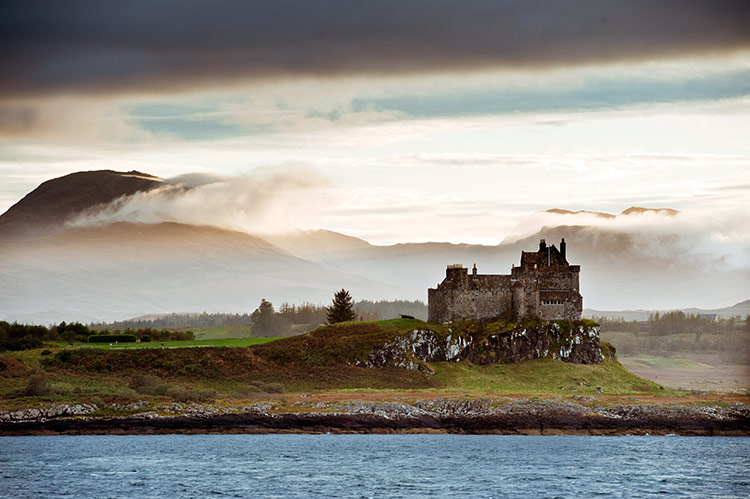
Duart Castle on Mull emerges from the mist. Image by Gregory Heath / Moment / Getty Images
There are few more beautiful places on Earth. Some of Europe’s best beaches are here (though don’t expect to come home with a suntan) while remoteness and underpopulation mean that wildlife displaced elsewhere still flourishes. That very same isolation – Edinburgh seems another world, and London is outside the Hebridean solar system – means that life has traditionally been a tough, self-reliant affair. Buildings and towns are usually practical bases rather than an end in themselves. So lace up the hiking boots, grab binoculars or a paddle, fortify yourself with a local dram and get ready to explore.
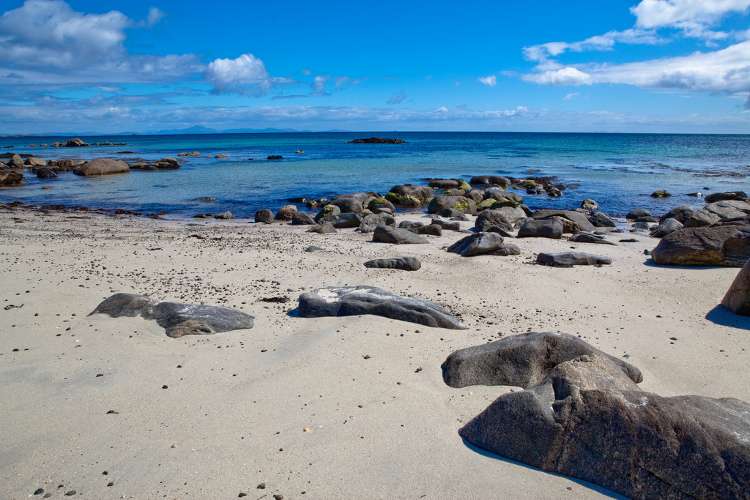
A bright day near Crossapol. Image by Nick Jewell / CC BY 2.0
Visiting the Hebrides is about being outdoors. The freshness of the air, the scent of turf and sea on the breeze, and the glorious wildness and solitude of the place make exploring under your own steam a delight. Throughout the islands there’s great walking, from pacing the sublime sandy beaches of Barra, Tiree or Harris to tackling the rugged challenge of Skye’s Cuillin Hills or the Paps on Jura. To get out on the water, sea-kayaking is a great option on Barra, Skye and other islands. And bikes are easily taken on ferries – though high winds can make for tough pedalling at times.
Scotland’s reputation for cookery was once more Michelin man than Michelin star but times have changed, and it’s the west’s sustainable fruits of the sea that have led the charge. Langoustines and crabs fresh off the boat, hand-dived scallops and tasty mussels and oysters mean it’s a seafood paradise. Lamb and beef from heather-grazing free-roaming animals are delicious, while Stornoway is famous for its black pudding. Try accompanying your meal with one of the local single-malt whiskies; there’s enough variety that you’ll be able to match any flavour.
The Hebrides are a particular haven for birds and aquatic mammals. The northwest – especially Skye and the Western Isles – is great for spotting otters along the shore. Mull is one of Britain’s best spots for whale watching, while dolphins and porpoises are common. You’re almost guaranteed to see seals, both the Atlantic grey (look for its Roman nose) and the common seal (recognisable by its doggy face). Birdwatchers flock to Islay and the Uists to see the corncrake, while Harris offers golden eagles. Seabirds – gannets, fulmars, puffins and more – thrive on jagged coasts while geese of various species often outnumber residents. But the fiercest of all Scottish creatures is one of the smallest. The highland midge descends in biting clouds on summer mornings and evenings (and can still pack a punch in spring and autumn): take strong repellent.
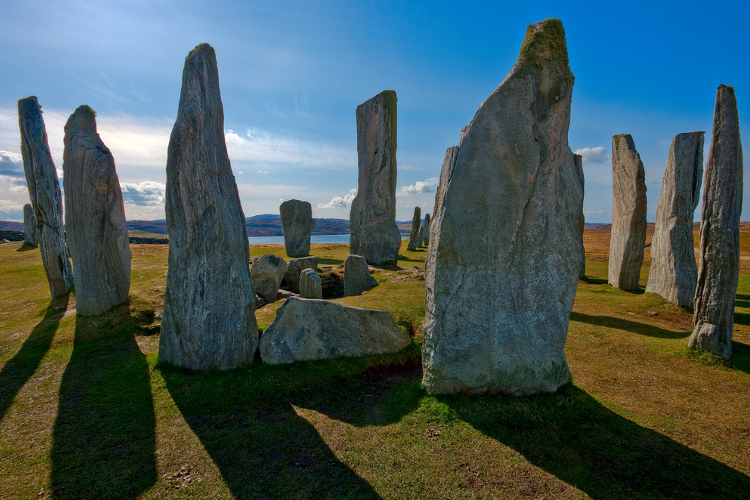
The Callanish standing stones on Lewis are as old as the Great Pyramid of Giza. Image by Andrew Bennett / CC BY 2.0
Majestic stone carvings and crosses from this outpost of early Christianity dignify several of the islands, most notably Iona. But these are modern architecture compared to the Dun Carloway broch of Lewis, some two thousand years old, and the Callanish standing stones, weighing in at some four and a half millennia, roughly contemporary with the Great Pyramid of Giza. The castles studded across the islands are relative newcomers, built by various clan chiefs – including the Lords of the Isles, who ruled the whole of the Hebrides and some of the mainland in the 14th and 15th centuries.
The friendliest of islands, Islay (‘eye-lah’) is the home of several of the world’s best whiskies – many famed for their peatiness – whose names reverberate on the tongue like a pantheon of Celtic deities. Ardbeg, Laphroaig, Lagavulin, Caol Ila, Bunnahabhain, Kilchoman, Bruichladdich, Bowmore. Stellar seafood and brilliant birdwatching are other reasons to come. The adjacent island of Jura provides the spectacular scenery, with its brooding twin hills, the Paps, providing habitat for an enormous deer population. The ferocious Corryvreckan whirlpool churns away at the north of the island, near where George Orwell wrote 1984.
Sleeping and eating: Get the best of Islay seafood and whisky, as well as seriously comfortable Victorian accommodation, at the Port Charlotte Hotel.
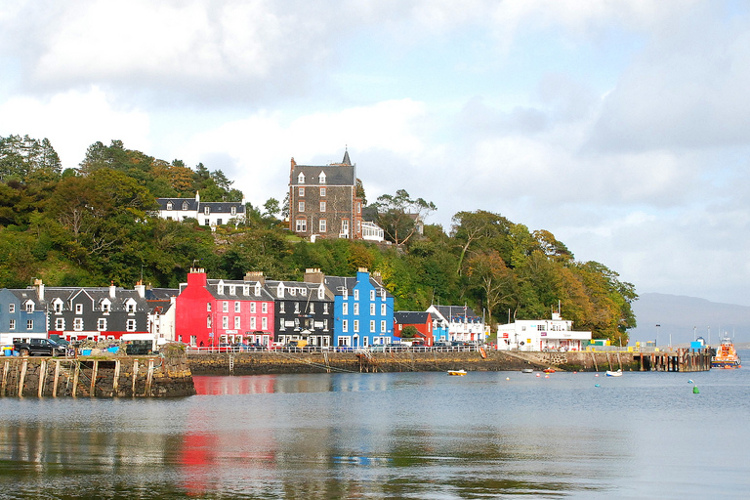
Tobermory is Mull's main town. Image by Richard Szwejkowski /CC BY-SA 2.0
Scenically stunning, with a mountainous backbone dropping to limpid waters, Mull has some of the finest Scottish scenery in a small, varied package, culminating perhaps in the spectacular angular hills dropping almost sheer into Loch Na Keal. The enchanting holy island of Iona just offshore is another huge attraction, while Mull’s main town, Tobermory, with its row of colourful houses and cracking pub, is one of the Hebrides’ most characterful settlements. Hillwalking, whale-watching excursions and boat trips to weird Fingal’s Cave on uninhabited Staffa are top activity choices.
Sleeping and eating: One of our favourite Scottish hostels is a working sheep croft on Iona. For something posher, the Highland Cottage Hotel in Tobermory is enchantingly intimate. Cafe Fish (thecafefish.com) is a sustainable seafood star, while the Mishnish (mishnish.co.uk) is one of the islands’ top spots for a pint.
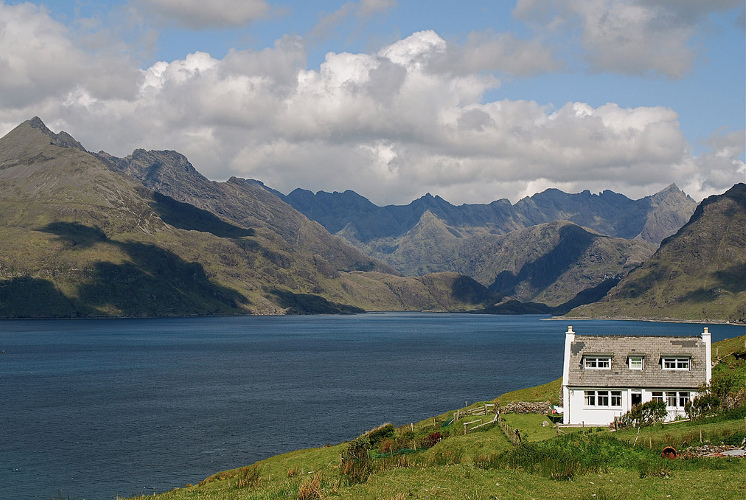
Cuillin Hills, Skye. Image by Thierry Gregorius / CC BY 2.0
The largest of Scotland’s islands is also one of its most spectacular. An ethereal light squeezes through the clouds and bathes a rugged splendour that reaches sublime levels with the Cuillin Hills, which thrust skywards in the south. Skye is a spot for everyone, with walkers plotting their assaults on a dozen major hills, sea-kayakers exploring coves and coast, and less energetic visitors cruising the island’s castles or sheltering from the drizzle in some of the inviting Skye watering holes. While crofting still goes on, Skye is very diverse; some residents these days are stockbrokers and designers working from home off quality internet connections.
Sleeping and eating: There are numerous options. For country hospitality, the Toravaig House Hotel offers the warmest of welcomes, while Three Chimneys (threechimneys.co.uk) combines stellar food with comfortable accommodation.
The Outer Hebrides (or Western Isles) are isolated, windswept, treeless places that have traditionally subsisted on fishing, weaving, and livestock, though renewable energy is increasingly big business. Scottish Gaelic is a working language here. The principal island, its northern half called Lewis and its southern Harris, is spectacular, offering wonderful coastal scenery, ancient stone monuments, traditional turf-roofed ‘blackhouses’ and the famous Harris tweed. To the south, the lonely Uists are prime naturewatching territory and connected by a causeway, while little Barra offers top sea-kayaking and the chance to watch the Glasgow flight land on the beach. Religion is deeply important in the Western Isles; there’s a Sunday shutdown as locals spend a day of churchgoing, contemplation and bible-reading.
Sleeping and eating: In a conserved village of traditional blackhouses on Lewis, one has been modernised and can be rented out: a great spot. In Stornoway, the main town, Digby Chick is the islands’ best place to eat.
Nearly all the ferries serving the Hebrides are operated by Calmac (calmac.co.uk). Skye is connected by bridge to the mainland. Bus services and friendly locals make getting around the islands easy enough, and every island has somewhere to hire bikes.
Some options: Explore Mull (isle-of-mull.net/about-us/explore-mull), Mull; Bowmore Post Office, Bowmore, Islay; Harris Outdoor Adventure, Leverburgh, Harris; Island Cycles, Portree, Skye.